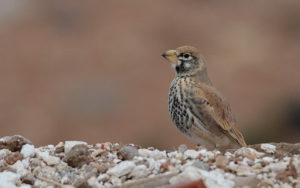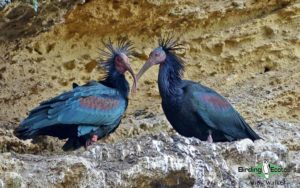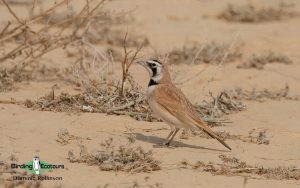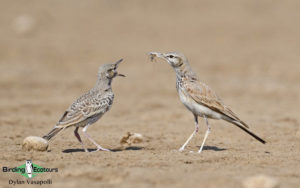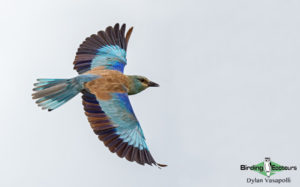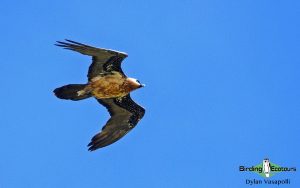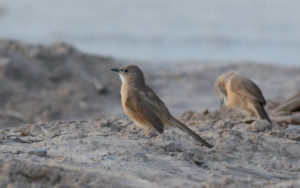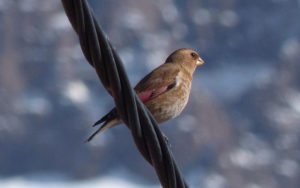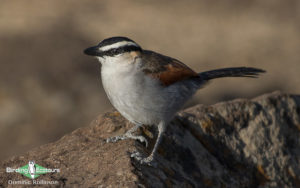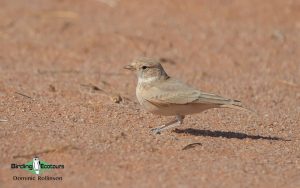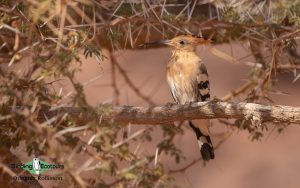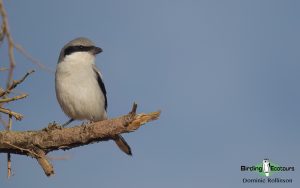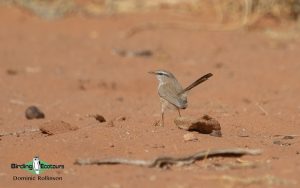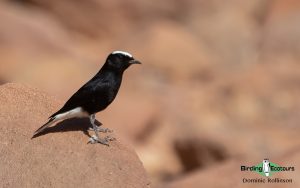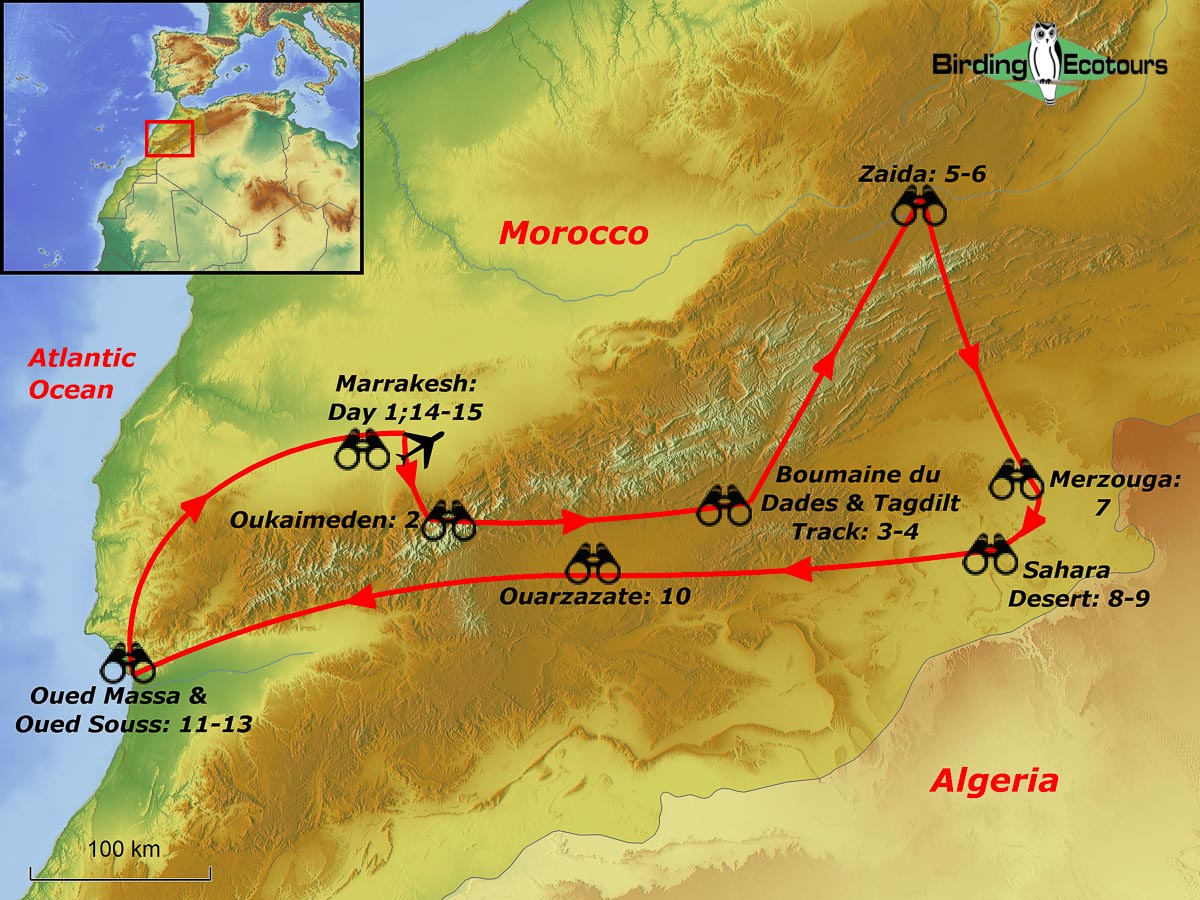Morocco: Best of Northwest Africa
Go to: Morocco Birding Tours | Birding Tours in Africa | Birding Tours in the Western Palearctic | All our birding tours
Birding Tour Morocco : Best of Northwest Africa
March 2026
Morocco is another of the Western Palearctic’s most exciting destinations. It offers a tantalizing mix of stunning scenery, fascinating history, awesome geography, and an outstanding list of bird species. Its position at the northwesternmost tip of the African continent makes it an important point in the African-Eurasian Flyway. Migrating birds leave in the spring and arrive in the fall on their northbound and southbound migrations respectively, this results in a simply superb list of migrant species and an amazing number of resident species too.
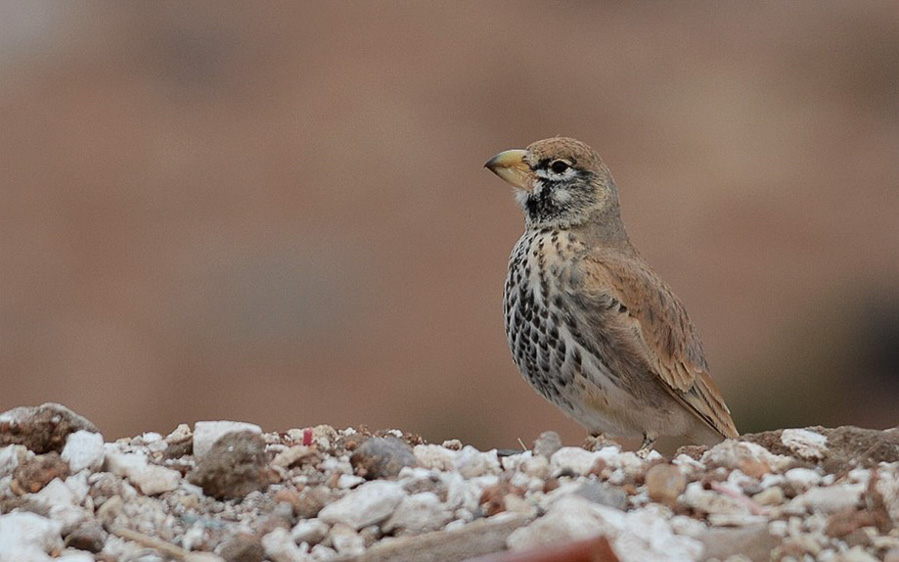
Morocco’s bird list currently stands at 518 species (following International Ornithological Congress (IOC) v13.1 taxonomy as of July 2023). This offers the visiting birder a huge variety of species, but it is the number of near-endemic and desert species which makes Morocco truly special. Our combination of expert international and local guides, a personally developed itinerary visiting the best places to go birding in Morocco, as well as a tour timed to visit the country at the best time of year, will result in a truly special adventure in this gateway to Africa.
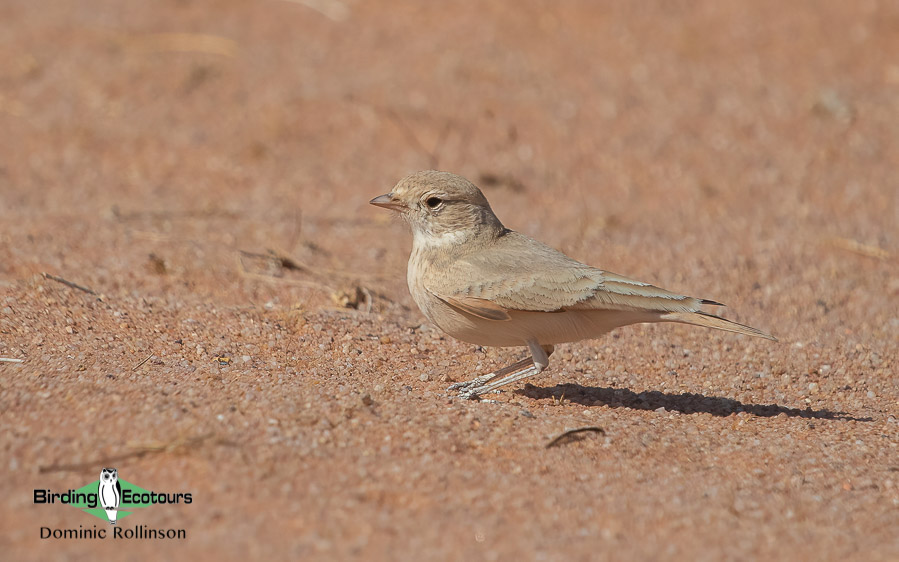
We begin our tour by heading to the stunning mountains of the High Atlas. Here an interesting range of species are on offer, ranging from African Crimson-winged Finch, Moussier’s Redstart, Barbary Partridge, and Levaillant’s Woodpecker, plus interesting species like Rock Sparrow, Blue Rock Thrush, Water Pipit, Horned (Shore) Lark, Red-billed Chough, and Alpine Chough. Raptors to keep an eye out for here include the magnificent duo of Golden Eagle and Bearded Vulture. We will also spend time in the mountains looking for migrant species such as Short-toed Snake Eagle, Montagu’s Harrier, Common Rock Thrush, Rufous-tailed Scrub Robin, Black Stork, and the gorgeous European Roller.
From the mountains we drop down into the vast deserts. Here we will come across some true desert species such as numerous larks, wheatears, and sandgrouse that have adapted to live in this harsh environment. These birds are often hounded by two desert hunters: the ‘Barbary’ subspecies of Peregrine Falcon and Lanner Falcon. We will explore desert waterways for wildfowl such as Ruddy Shelduck and these areas should also give us a huge number of migrant warblers such as Western Orphean Warbler and Western Subalpine Warbler (a gorgeous bird). Other migrants here can include Western Black-eared Wheatear, Eurasian Wryneck, and Bluethroat.
Moving further into the desert we can find stunning species such as the beautiful Blue-cheeked Bee-eater, as well as other key target species like Fulvous Babbler, Isabelline Wheatear, Barbary Partridge, and Striolated Bunting. Yet more interesting migrant species should include Eurasian Hoopoe, Woodchat Shrike, European Bee-eater, and many others.
As we move deeper into the desert some really special birds become possible, including Desert Sparrow, Greater Hoopoe-Lark, Thick-billed Lark, Temminck’s Lark, Bar-tailed Lark, Dunn’s Lark, Tristram’s Warbler, and with luck, the increasingly rare Houbara Bustard, a species which has declined rapidly due to pressure from hunting. We will also target other exciting species such as Egyptian Nightjar, multiple sandgrouse species, Cream-colored Courser, Pharaoh Eagle-Owl, Long-legged Buzzard, and much more. Here we will also look for the Streaked Scrub Warbler, a prized monotypic family.
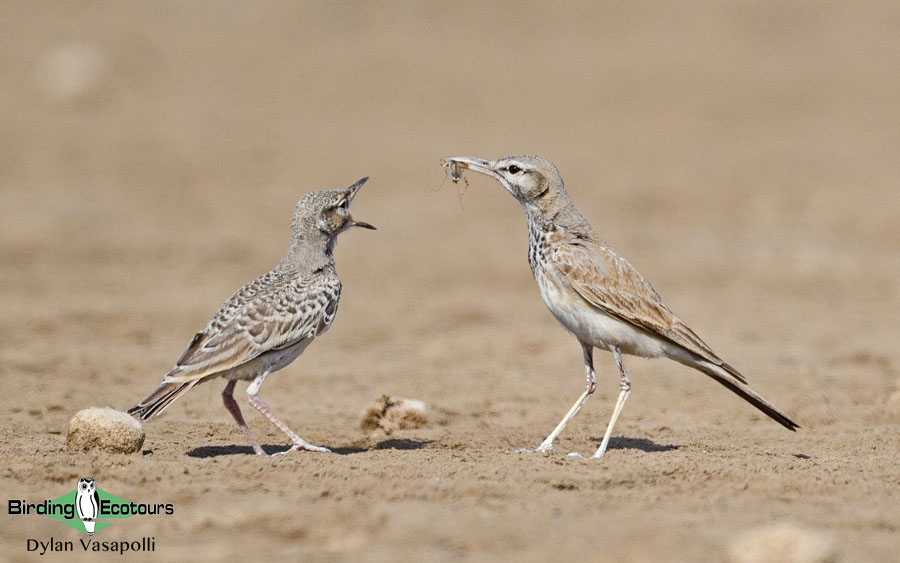
After our fill of desert birds, we will begin the long journey towards the Atlantic coast. We will stop for birding en route for more interesting migrant and resident species including Maghreb Wheatear and Bonelli’s Eagle. Upon reaching the coast, our primary target is the fascinating and Endangered (BirdLife International) Northern Bald Ibis. As we explore the rich and productive estuaries, rivers, and waterbodies here we could find Baillon’s Crake, Little Crake, Marbled Duck, Ruddy Shelduck, Squacco Heron, Purple Heron, Audouin’s Gull, Mediterranean Gull, Caspian Tern, and Brown-throated Martin.
We will also search these areas for Spotless Starling, Great Spotted Cuckoo, Zitting Cisticola, Red-rumped Swallow, Pallid Swift, and a variety of warblers including Savi’s Warbler, Western Olivaceous Warbler, and Moustached Warbler. Black-crowned Tchagra is another special bird of the region, and its rich, liquid calls ring out from the dense scrub; we will enjoy looking for this great member of the bushshrike family.
Finally, we head back inland via the Atlas Mountains and arrive in Marrakech for one final night. Upon arrival we have the option of enjoying the historic old quarter of Marrakech and the famous Jema-el-Fna square as we wrap up what is sure to have been a fantastic bird tour.
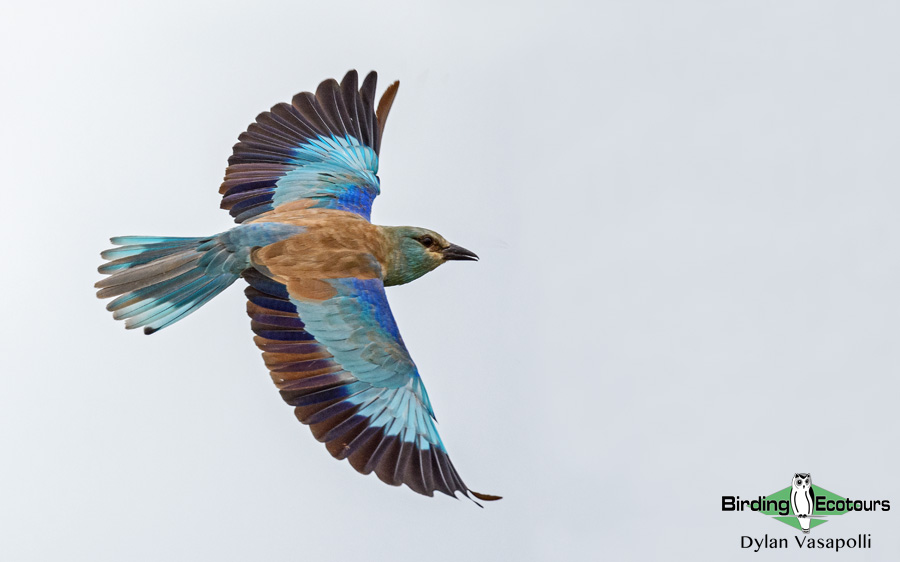
You might be interested to extend your stay in this part of the world by joining our Birding Tour Spain: Spring Birding Extravaganza tour, which follows this exciting tour through Morocco. This amazing 16-day tour of Spain takes in the whole country as we target species like Wallcreeper, Dupont’s Lark, Red-knobbed Coot, Iberian Magpie, Lesser Crested Tern, Great Bustard, Little Bustard, a wide variety of birds of prey including Bearded Vulture, Spanish Imperial Eagle, Cinereous Vulture, and Black-winged Kite, plus Black Stork, White-throated Dipper, Citril Finch, Iberian Grey Shrike, White-backed Woodpecker, Alpine Accentor, White-winged Snowfinch, and Moustached Warbler, plus many more.
If you cannot make the dates of this scheduled tour, please get in touch and we would be happy to help build a custom tour with dates to suit you.
Itinerary (15 days/14 nights)
Day 1. Arrival in Marrakesh
You will be met at Marrakesh Menara Airport by your experienced team of guides (a Birding Ecotours tour leader will accompany this tour with our excellent Moroccan local guide), and you will be transferred to your comfortable hotel for the night. This will be a great opportunity to relax after your journey to Morocco before the birding starts the next day.
Once the entire group has arrived, we will meet to discuss the itinerary of the trip and use this time to facilitate with anything the group may need. In the evening we will meet to have a group welcome meal. You may of course decide you want to arrive ahead of the tour to explore this fascinating and historic city. We can help you with any extra activities and accommodation.
Overnight: Hotel Mogador Opera, Marrakesh
Day 2. Birding the High Atlas Mountains and Oukaimeden
After a traditional breakfast, where the sound of Pallid Swift and Little Swift screeching overhead may greet us, we will drive up into the High Atlas Mountains and visit Oukaimeden at 8,530 feet (2,600m), which lies on the edge of the Parc National de Toubkal. This stunning area in the High Atlas Mountains is a popular ski resort, but it is also a fantastic area for birding.
As we drive by the cultivated fields on our way into the mountains, we should find a good mix of resident species such as Great Grey Shrike (likely to be the algeriensis subspecies, sometimes referred to as Sahara Grey Shrike, along with the elegans subspecies that also occurs in Morocco), Little Owl, Sardinian Warbler, Spotless Starling, Maghreb Magpie (a recent split from Eurasian Magpie), Moussier’s Redstart, White-throated Dipper, African Blue Tit, and House Bunting.
As we gain altitude, among the rocky slopes, we will search for Black Wheatear and the regional endemic Levaillant’s Woodpecker. When we reach the ski resort at Oukaimeden, we will check the snowline for the handsome African Crimson-winged Finch. Other species here include Rock Sparrow, Alpine Chough, Red-billed Chough, Atlas Wheatear, Water Pipit, and the Atlas Mountain subspecies of Horned (Shore) Lark (the atlas subspecies and another potential future split). Raptors to keep an eye out for during the day include Golden Eagle and possibly the majestic Bearded Vulture too. It is sure to be a thoroughly exciting start to our Morocco bird tour.
Overnight: Aurocher Oukaimeden Hotel, Oukaimeden
Day 3. Birding the High Atlas Mountains to the foothills
After an early breakfast we leave the mountains behind, perhaps pausing again en route for Levaillant’s Woodpecker, as well as African Blue Tit, Red (Common) Crossbill (the poliogyna subspecies), and African Chaffinch (a recent split from Common Chaffinch).
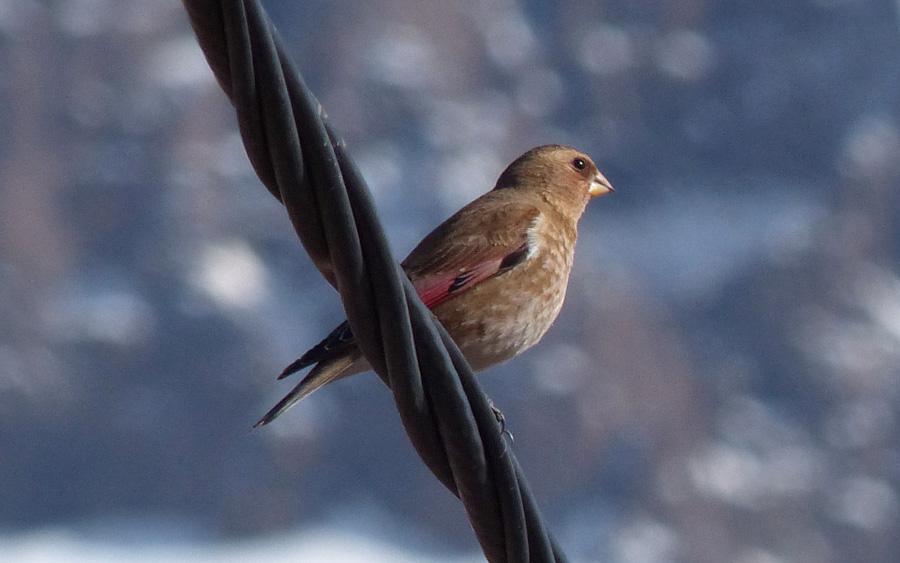
From the flat plains of Marrakesh, we turn back uphill, and drive to Boumalne du Dades via the famous Tizi-n-Tichka Pass at 7,414 feet (2,260 meters), which is a spectacular drive and is sure to be an enjoyable experience. At the pass we will try for yet another regional endemic, Tristram’s Warbler. This species has very specific habitat requirements away from its wintering grounds and it is not always an easy bird to find but we will put in the effort required. As the road climbs into the hills, we may start to see some raptors such as Long-legged Buzzard and Bonelli’s Eagle, while other notable species could include Eurasian Hoopoe, Woodchat Shrike, Thekla’s Lark, Laughing Dove, Common Bulbul, Black Wheatear, and hirundines like Red-rumped Swallow, Common House Martin, and Eurasian Crag Martin.
Before reaching Boumalne du Dades we will stop in Amerzgane to look for the rare Maghreb Wheatear (a recent split from Mourning Wheatear). Other birds we might find here include a range of migratory passerines such as Woodchat Shrike, Western Subalpine Warbler, Common Whitethroat, Common Redstart, Eurasian Blackcap, Common Nightingale, Western Yellow Wagtail, and potentially many more.
Overnight: Riad Dades Birds, Boumaine du Dades
Day 4. Birding the Tagdilt Track
Today we will start early, to head to the famous Tagdilt Track. This is without doubt one of the top areas for birding in southern Morocco. In fact, the whole area around Boumalne du Dades is sensational for birding and we could see a huge range of specials of the region and migratory species moving north towards Europe during our time here.
While exploring the track we will keep our eyes peeled for key species like Houbara Bustard, Cream-colored Courser, Long-legged Buzzard, Black-bellied Sandgrouse, Crowned Sandgrouse, White-crowned Wheatear, Red-rumped Wheatear, Desert Wheatear, Trumpeter Finch, and a whole range of larks including Thekla’s Lark, Temminck’s Lark, Greater Short-toed Lark, Bar-tailed Lark, and the highly nomadic Thick-billed Lark.
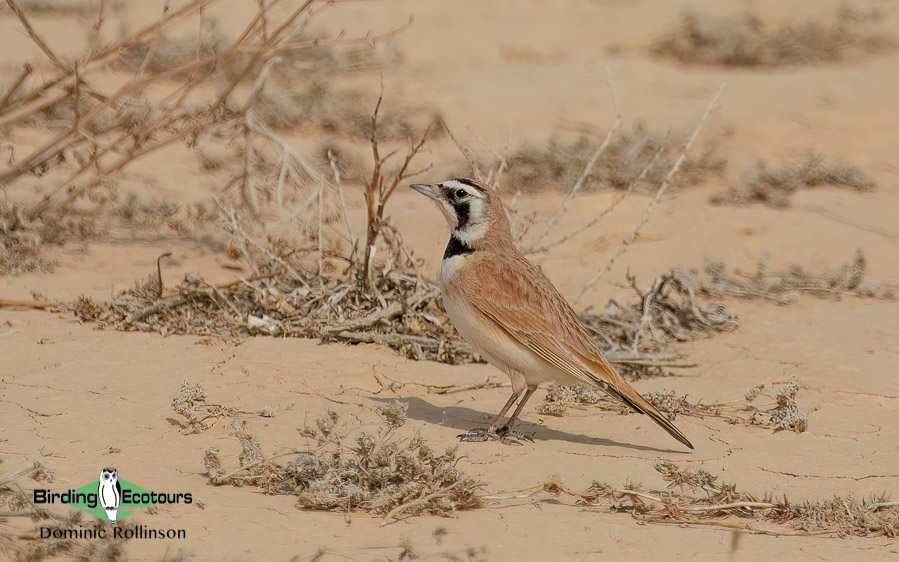
We will also keep our eyes peeled for Europe-bound migrants like Eurasian Stone-curlew, White Stork, Northern Wheatear (of the long-distance migratory subspecies), Tawny Pipit, Little Ringed Plover, Western Black-eared Wheatear, Common Cuckoo, and Common Redstart.
If the heat allows, we will dedicate most of our day to exploring this area, and in the afternoon, we will visit a rocky canyon searching for Maghreb Wheatear, Desert Lark, and our first chance of the stunning Pharaoh Eagle-Owl.
Overnight: Riad Dades Birds, Boumaine du Dades
Day 5. The Todra Gorge and Zaida
Today we will begin by visiting the Todra Gorge, just to the north of the town of Tinghir. This is yet another highly productive birding area with specials like Streaked Scrub Warbler – a highly sought-after monotypic family, Tristram’s Warbler, Black Wheatear, Blue Rock Thrush, Eurasian Crag Martin, wild and native Rock Dove, and House Bunting, all in attendance. The wider list of passerines here can be vast, and our visit could also give us sightings of White-crowned Wheatear, Black Wheatear, Western Black-eared Wheatear, Spectacled Warbler, Western Bonelli’s Warbler, Desert Lark, Bar-tailed Lark, and many more. The gorge is also excellent for birds of prey with Bonelli’s Eagle, Short-toed Snake Eagle, Booted Eagle, Western Marsh Harrier, Black Kite, Long-legged Buzzard, and Common Kestrel all regular species in the area.
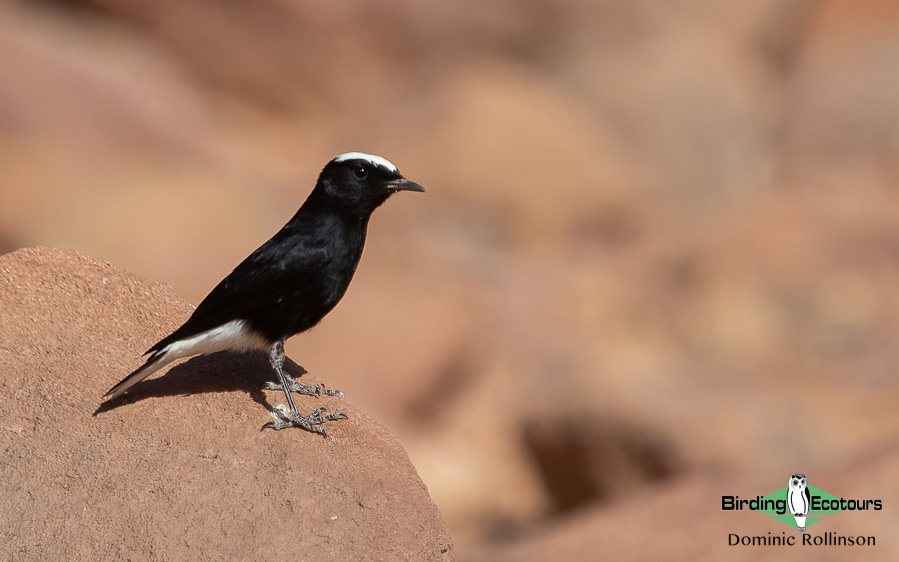
Later in the day we will travel northwards to Zaida to look for the Vulnerable (BirdLife International) Dupont’s Lark. This species has seen rapid declines across many of its key breeding areas and as such is becoming a must-see species. We will also have a further chance for this species tomorrow.
Overnight: Hotel Ksar Timnay, Zaida
Day 6. The Zaida Plain
Today will be an early start as we head to the Zaida Plain to search for Dupont’s Lark. The plains are another excellent birding site, with a wide range of species possible, including Seebohm’s Wheatear, Desert Wheatear, Red-rumped Wheatear, Moussier’s Redstart, Trumpeter Finch, Black-bellied Sandgrouse, Spectacled Warbler, Thekla’s Lark, Mediterranean Short-toed Lark, Temminck’s Lark, and Greater Short-toed Lark.
Areas of water on the plains may give us the fascinating glimpse of the life of waterbirds in the desert, an odd fact to get your head around (waterbirds in the desert!), with species such as Little Grebe, Ferruginous Duck, Common Moorhen, and Eurasian Coot possible, plus migrant shorebirds (waders) like Little Ringed Plover, Black-tailed Godwit, and Green Sandpiper. This water may also attract desert species to drink, with beautiful Crowned Sandgrouse and Pin-tailed Sandgrouse both often seen here.
Provided the heat does not get too high, we will spend the entire day exploring this exciting area on the edge of the Anti-Atlas Mountains; we are certain to be in for another thrilling day.
Overnight: Hotel Ksar Timnay, Zaida
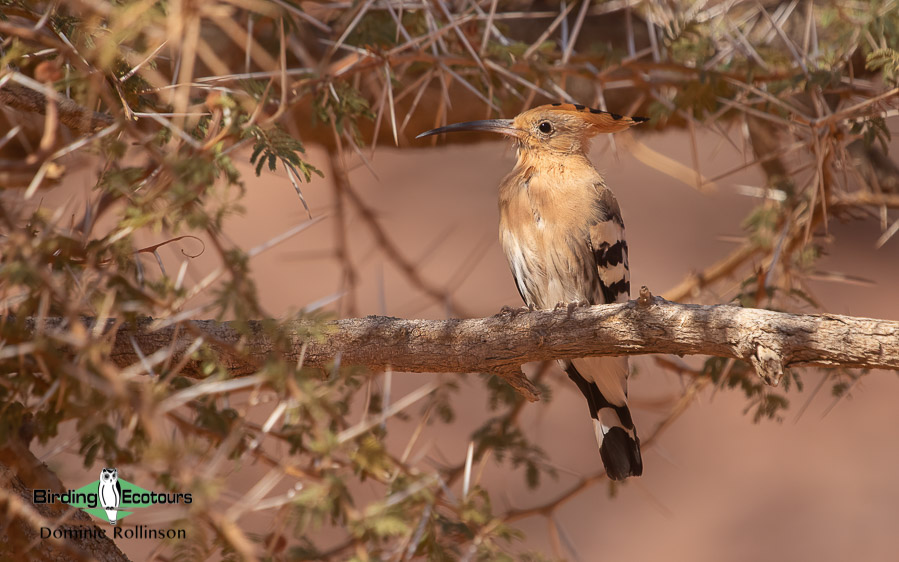
Day 7. Arrival in the Sahara Desert
After breakfast in our hotel, we will head south to the edge of the Sahara Desert, one of the most exciting parts of our tour. This journey will take us around five hours, but we will break up the journey with stops for birding. Along the route we may see Eurasian Crag Martin, Desert Lark, Black Wheatear, White-crowned Wheatear, Blue Rock Thrush, and many more species we may have encountered in previous days.
Also, on the journey we will stop at a scrubby wadi (dry river valley) to again seek out the elusive Streaked Scrub Warbler. This species is widespread across much of North Africa, the Middle East, and Central Asia but, being a monotypic family, makes it an extremely exciting one to see, especially considering it is tricky to access across much of its range. While looking for this interesting species, we may also find Thick-billed Lark and Trumpeter Finch, plus many other desert species.
Overnight: Hotel in Merzouga
Days 8 – 9. Birding the Sahara Desert
We will spend two full days in the Sahara Desert and explore the area around the town of Merzouga using comfortable 4×4 vehicles. While in Merzouga we will stay in a delightful kasbah which has attractive gardens. These gardens are a huge draw to migrant species as they make their way across this harsh desert environment, at this time of year returning from southern or West Africa back to northern Europe to breed (before making the return journey a few months later – we will enjoy seeing and learning about the incredible life histories of many of these migratory birds).
Typical species we may come across in the gardens here include Eurasian Collared Dove, Laughing Dove, Iberian Chiffchaff, Common Chiffchaff, Western Subalpine Warbler, Sardinian Warbler, Common Blackbird, Black Redstart, European Serin, Eurasian Hoopoe, Tree Pipit, Western Olivaceous Warbler, Eastern Olivaceous Warbler (localized reiseri subspecies, touted as a potential split), Song Thrush, European Robin, European Pied Flycatcher, Eurasian Wryneck, and Common Nightingale. Overhead the beautiful bubbling calls of European Bee-eater and Blue-cheeked Bee-eater will accompany us as we bird in this remote part of the Sahara. We may also get a visit from the desert’s special species looking for shelter from the heat, with Tristram’s Warbler, White-crowned Wheatear, Desert Sparrow, and the striking Greater Hoopoe-Lark all possible in the area.
We will also explore the vast red dune known as Erg Chebbi. This is part of the largest dune system in Morocco and a stunning backdrop to our birding here. The kasbah cafes in the area are good places to stop for a cold drink and to get incredible views of Desert Sparrow and White-crowned Wheatear. In the wider landscape, we should come across several desert specials like Fulvous Babbler, Bar-tailed Lark, Dunn’s Lark, Desert Wheatear, African Desert Warbler, Trumpeter Finch, Brown-necked Raven, Crowned Sandgrouse, Spotted Sandgrouse, Lanner Falcon, and Peregrine Falcon (formerly Barbary Falcon and a possible future split as more scientific studies are carried out on the complex). We will also have a good chance of seeing Egyptian Nightjar as they roost in the day, though we will need to ensure our eyes are not just painted on, as they are very well camouflaged and blend in very well to their chosen roost spot!
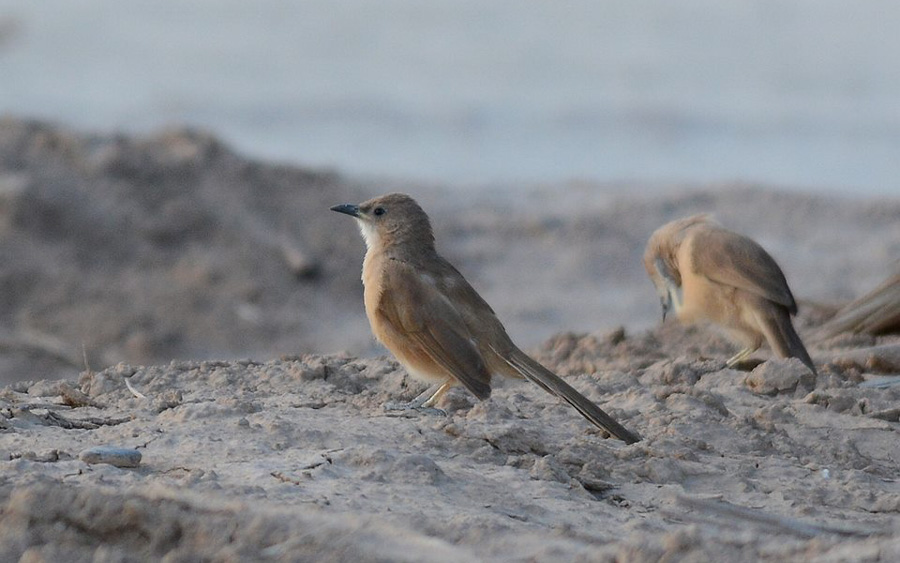
The Dayer Srij lake at the southern edge of the dunes can also be an excellent spot for migrant shorebirds (waders) with other wetland species also likely to be present too, including a flock of over 1,000 Greater Flamingo that often reside here – what a spectacular sight! Shorebirds such as Black-winged Stilt, Pied Avocet, Kentish Plover, Little Ringed Plover, Ruff, Common Greenshank, Green Sandpiper, Dunlin, and Little Stint are all likely here, while wildfowl like Ruddy Shelduck, Common Shelduck, Northern Shoveler, Gadwall, Mallard, Tufted Duck, and the Vulnerable (BirdLife International) Marbled Duck can all be found.
Overnight (two nights): Hotel in Merzouga
Day 10. Transfer to Ouarzazate via the Anti-Atlas Mountains
Today we will make the long drive back across central Morocco towards Ouarzazate, a stunning town and fortress in the foothills of the Anti-Atlas Mountains, famous for appearing in Game of Thrones, Gladiator, and many other films and TV shows!
During our five-hour journey we will stop for birding and we should find common scrub species like White-crowned Wheatear, Great Grey Shrike, and others mentioned previously. Before reaching Ouarzazate, we will stop and scan the vast Barrage El Mansour Eddahbi. This is another hugely productive site with over 200 species recorded here, with the peak activity and abundance of birds being during our visit.
This massive lake is a fantastic spot for us to find a huge range of wildfowl, shorebirds (waders), herons, egrets, birds of prey, gulls, terns, hirundines, and passerines. Its position, and the attraction of resident and migrant birds to water, makes it a site where literally anything could turn up. To give you an idea of the variety on offer here, interesting species regularly include Ruddy Shelduck, Booted Eagle, Black Kite, Thekla’s Lark, Marbled Duck, Alpine Swift, Little Swift, Wood Sandpiper, Little Owl, Eurasian Hoopoe, European Bee-eater, Peregrine Falcon, Thick-billed Lark, Desert Lark, Maghreb Lark, Western Olivaceous Warbler, Melodious Warbler, Common Bulbul, Spectacled Warbler, Black Wheatear, Maghreb Wheatear, Trumpeter Finch, Greater Flamingo, Purple Heron, Gull-billed Tern, Little Stint, Cream-colored Courser, Lesser Kestrel, Bluethroat, Blue-cheeked Bee eater, and so much more! It is sure to be an exciting visit with an eclectic mix of species on the cards.
Overnight: Hotel Le Fint, Ouarzazate
Day 11. The Souss Valley and Agadir
Today we will continue our long drive west over the Anti-Atlas Mountains and into the Souss Valley. We will once again make many stops along the route looking for new and exciting birds.
Within the Souss Valley we will search for interesting species like Black-crowned Tchagra, Laughing Dove, Cirl Bunting, Rufous-tailed Scrub Robin, and Spanish Sparrow. Migrant birds of prey are often seen along the valley with Short-toed Snake Eagle, Booted Eagle, Montagu’s Harrier, and Black Kite being the most likely species to be observed. We also have another good chance of finding the highly sought after Tristram’s Warbler.
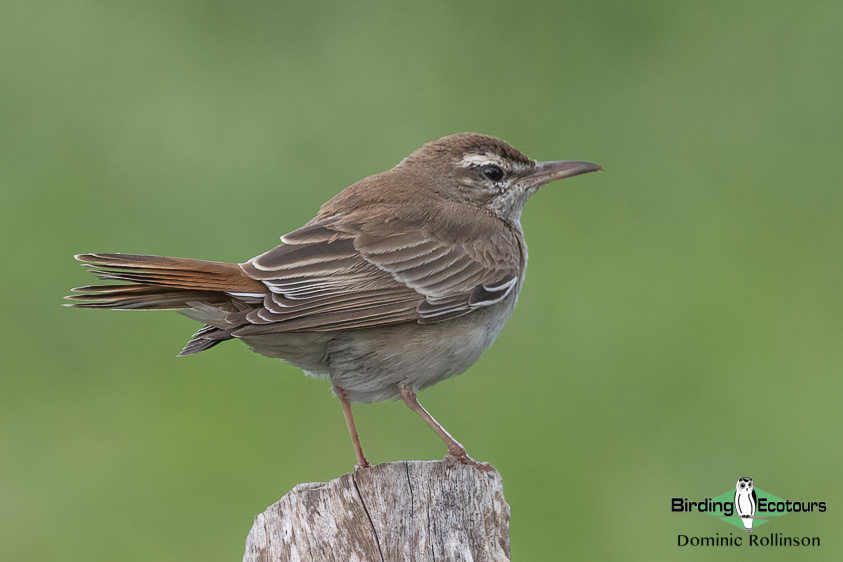
We make a stop in the town of Taroudant where large numbers of Little Swift and Pallid Swift may be seen over the town, often giving stunning views. Around the town we may also find exciting species like Maghreb Magpie, Moussier’s Redstart, White-crowned Wheatear, House Bunting, Common Bulbul, African Blue Tit, Fulvous Babbler, Barbary Partridge, and Levaillant’s Woodpecker. The area is also a great migration hotspot with European-bound migrants like Spotted Flycatcher, Spotted Crake, White Stork, Sedge Warbler, Western Orphean Warbler, Common Cuckoo, and European Turtle Dove being regular sightings here during the time of our visit.
Finally, we will reach the Atlantic coast and the city of Agadir, where we will be based for the following three nights as we explore the next wonderful area on our tour.
Overnight: Hotel Aferni, Agadir
Day 12. Birding Oued Massa and Oued Souss
Today we will explore the fantastic coastal wetlands of the Oued Massa National Park. This highly productive area is home to an incredible mix of resident and migrant species, with significant numbers of shorebirds (waders), wildfowl, gulls, terns, herons, egrets, birds of prey, and passerines possible. Like other areas on our tour, Oued Massa has several key target species, including Black-crowned Tchagra, Marbled Duck, Moussier’s Redstart, Sardinian Warbler, Little Owl, Eurasian Stone-curlew, Laughing Dove, and Brown-throated Martin.
Other notable species here include Garganey, Slender-billed Gull, Gull-billed Tern, Caspian Tern, Little Bittern, Glossy Ibis, Eurasian Spoonbill, Kentish Plover, Cream-colored Courser, Western Olivaceous Warbler, Western Black-eared Wheatear, Great Spotted Cuckoo, Mediterranean Short-toed Lark, and much more.
Later in the day we will visit the Oued Souss, the mouth of the Oued Massa River. This is yet another excellent birding site, especially for shorebirds (waders), gulls, and terns. It is here we should get our first sightings of the Vulnerable (BirdLife International) Audouin’s Gull. This stunning species is often seen in small numbers among the much larger numbers of Yellow-legged Gull and Lesser Black-backed Gull. Other interesting species we should come across here include Greater Flamingo, Zitting Cisticola, Western Subalpine Warbler, Marbled Duck, Collard Pratincole, Ruddy Shelduck, Lesser Kestrel, Whiskered Tern, and Maghreb Magpie.
Overnight: Hotel Aferni, Agadir
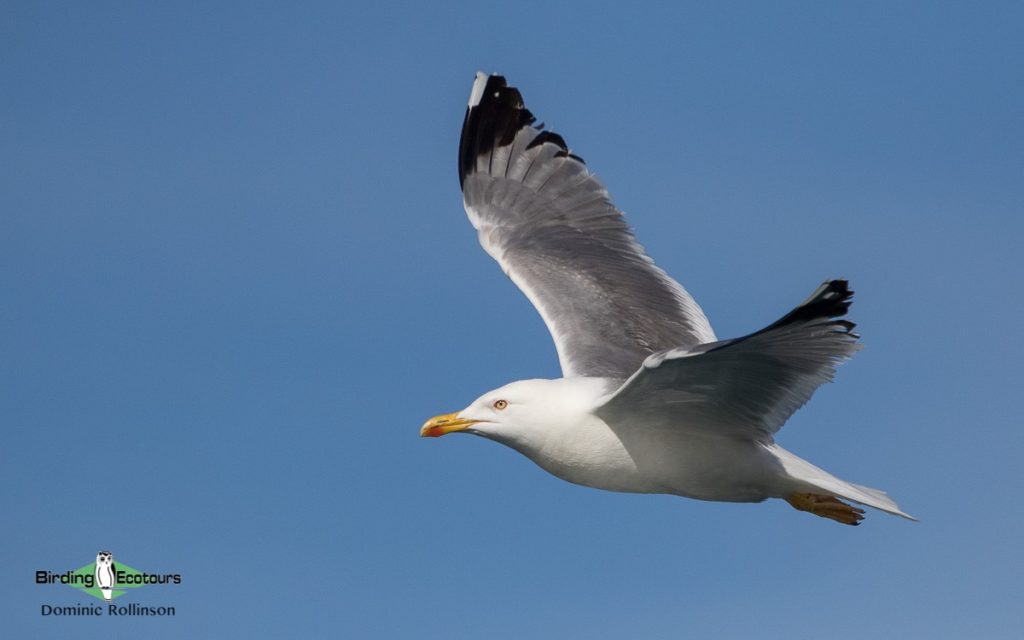
Day 13. Birding the Atlantic coast
After breakfast we will once again explore the Atlantic coast around Agadir. Firstly, we will head to a local beach to search for Audouin’s Gull and witness the sight of hundreds of Lesser Black-backed Gull and Yellow-legged Gull roosting on the beach. The Lesser Black-backed Gulls here are a mix of two subspecies with graellsii, which breeds in north west Europe, and intermedius, which breeds in northern Europe and Scandinavia, both being present. We may also get lucky and spot Parasitic Jaeger (Arctic Skua) moving offshore.
After lunch we will head north to the remote coastal areas around Tamri. Here we will come across many species we have seen previously, but the real purpose of our visit is to find the bizarre-looking Northern Bald Ibis. This Endangered (BirdLife International) species is one of the world’s rarest birds, with Morocco holding 95% of the current wild population, or an estimated 700 birds.
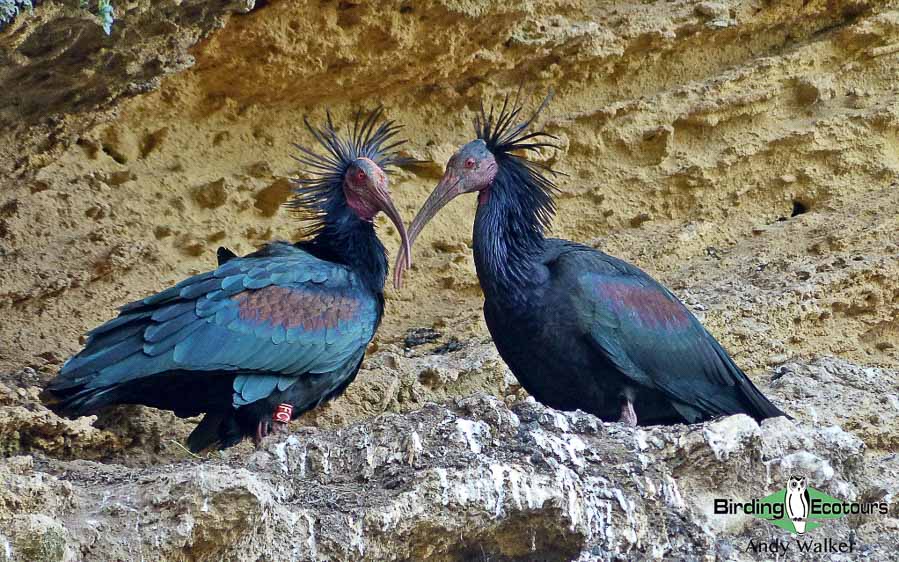
While around Tamri we will explore the coastal scrub and fields in search of other attractive species like European Bee-eater, Sardinian Warbler, Moussier’s Redstart, Back-crowned Tchagra, Brown-throated Martin, Common Bulbul, Black Wheatear, Woodchat Shrike, Calandra Lark, and European Serin. Offshore we may find passing seabirds like Northern Gannet, Great Skua, Parasitic Jaeger (Arctic Skua), and Balearic Shearwater.
Overnight: Hotel Aferni, Agadir
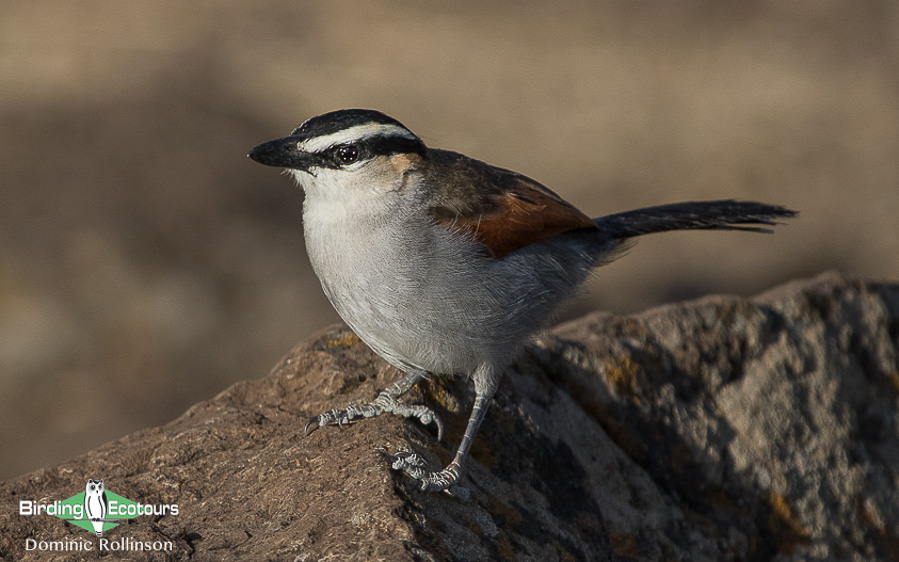
Day 14. Transfer from Agadir to Marrakesh
Today we will make the journey back from Agadir, across the Atlas Mountains, to Marrakesh. En route, we will make several stops to look for any interesting species and also enjoy stunning Moroccan scenery for the final time. In the evening we have the option of visiting the old quarter of Marrakesh, including the impressive Jema-el-Fna square, which is a remarkable experience for any visitor. Here we can enjoy the vast number of stalls of the Souk and you can even try your hand at bartering, an ideal opportunity to get some souvenirs! We will enjoy our final traditional Moroccan meal together and go through our final trip list. Our international and local team will be on hand to answer any queries you have with bird identification, and as a group we will need to choose our ‘bird of the trip’.
Overnight: Hotel Mogador Opera, Marrakesh
Day 15. Departure from Marrakesh
A non-birding day. After breakfast at our hotel, we will head to Marrakesh airport where the tour will conclude in the mid-morning. You may like to extend your stay in this part of the world by joining our Birding Tour Spain: Spring Birding Extravaganza tour where we find a complementary set of great birds to those here, such as Wallcreeper, Iberian Magpie, Great Bustard, Little Bustard, Spanish Imperial Eagle, Cinereous Vulture, Citril Finch, Iberian Grey Shrike, Alpine Accentor, White-winged Snowfinch, and many more.
Overnight: Not included
Please note that the itinerary cannot be guaranteed as it is only a rough guide and can be changed (usually slightly) due to factors such as availability of accommodation, updated information on the state of accommodation, roads, or birding sites, the discretion of the guides and other factors. In addition, we sometimes must use a different international guide from the one advertised due to tour scheduling.
Download ItineraryUseful information
During this Morocco tour, your guide will be driving you in a comfortable vehicle. The tour does not require a great deal of walking or steep hiking to see the bulk of the birds, though there are opportunities for longer hikes if you wish and we may climb the Erg Chebbi dune which is an incredibly challenging climb due to the heat and sand (this climb will be optional through). The highest altitudes involved are usually between 6,500 – 8,200 feet (2,000 – 2,500 meters), but only for one or two days of the tour, as we target the high-elevation specials of the area.
The temperatures during the tour will be wide-ranging. The weather during the High Atlas section of our tour could be highly variable, and we should be prepared for rain showers. Temperatures here should be between 52 – 64oF (11 – 18oC). The rest of the tour is more settled with temperatures on the coast being a comfortable 68 – 72oF (20 – 22oC) and temperatures in the desert area usually 75 – 79oF (24 – 26oC), however we could see the temperature rise to 88oF (31oC) on occasion. Nights in the desert are cold, with temperatures often dropping to 41 – 50oF (5 – 10oC).
Your accommodations all have private bathrooms and will be comfortable and attractively appointed in the local style. The larger towns and cities will have more upmarket hotels while those in the desert will be more traditional.

